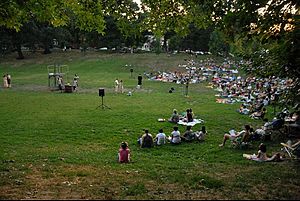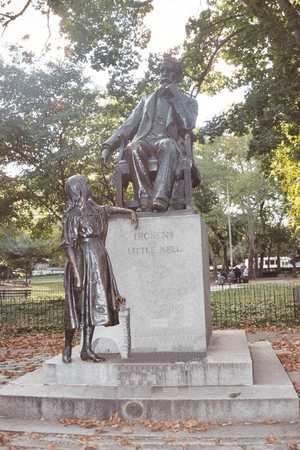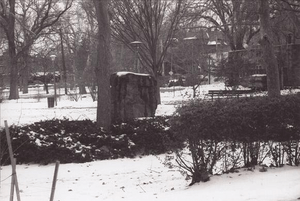Clark Park facts for kids
Quick facts for kids Clark Park |
|
|---|---|
| Clarence H. Clark Park | |

An August 2007 performance of "Romeo and Juliet" by Shakespeare in Clark Park.
|
|
| Location | West Philadelphia, Pennsylvania |
| Area | 9.1 acres |
| Created | 1895 |
| Operated by | Philadelphia Parks & Recreation |
| Status | Always open |
| Website | |
|
Clark Park
|
|
|
U.S. Historic district
Contributing property |
|
| Location | Pennsylvania |
| Area | 640 acres (259 ha) |
| Architect | multiple |
| Architectural style | Queen Anne, Colonial Revival, Classical Revival |
| Part of | West Philadelphia Streetcar Suburb Historic District (ID97001669) |
| Added to NRHP | February 5, 1998 |
Clark Park is a cool municipal park located in West Philadelphia, Pennsylvania. It's about 9.1 acres big and sits between 43rd and 45th streets, and Baltimore and Woodland Avenues.
The park was created in 1895. A kind banker and developer named Clarence Howard Clark gave the land to the city. For many years, it was known as "Clarence H. Clark Park."
Today, Clark Park is a busy place! It has a basketball court, a fun playground, and a big open field. There are also many paths for walking or biking.
One special thing in the park is a life-sized statue of the famous writer Charles Dickens. It was made in 1890 and is one of only two statues of him in the world. The park is also home to the Shakespeare in Clark Park theater group, which puts on plays.
You can also find Philadelphia's biggest year-round farmers' market here. It happens once or twice a week, depending on the season. It's a great place to get fresh food!
Contents
Park's Past: A Look Back in Time
How Clark Park Began
Before Clark Park was a park, it had a different history. During the American Civil War, a small part of the land was used by Satterlee General Hospital. This was a huge hospital for Union Army soldiers. About 60,000 soldiers were treated there! The hospital was taken down after the war.
A cool part of the park is its "bowl" area. This used to be a mill pond! It powered a paper mill and another mill nearby. There was even an ice house close by. A creek called Mill Creek fed the pond.
The mills closed in the 1860s. As more houses were built, the creek was buried, and the pond dried up. By the 1890s, the land was even used as a public dump.
In 1894, people wanted to turn the land into a park. Most of it belonged to Clarence Howard Clark. He made a deal with the city: he would give the land for the park if the city didn't make him pay for street improvements. The city agreed, and the park was officially created on June 8, 1894. Clark wanted the park to be especially for children.
The first part of the park opened on January 18, 1895. A few years later, in 1898, more land was added. This gave the park its current 9.1-acre size.
The Dickens Statue: Dickens and Little Nell

The famous Dickens statue was made by Francis Edwin Elwell. It shows Charles Dickens with one of his characters, Nell Trent, from his book The Old Curiosity Shop. The statue won awards in 1891 and 1893.
In 1896, the Fairmount Park Art Association bought the statue for $7,500. It was placed in Clark Park the next year. People loved it so much that some even wanted to move it to a more central spot in the city, but it stayed in Clark Park.
Sadly, the statue was damaged by vandals in 1989. But don't worry, it was fixed and restored!
Park Improvements Over Time

In 1916, a large stone from Devil's Den at Gettysburg Battlefield was placed in the park. It's there to remember the Union soldiers treated at the hospital that once stood on the site. It also honors the people who cared for them. You can find this stone near the park's northwestern corner.
In 1961, the city spent money to make the park even better. They added a basketball court, a shuffleboard court, and checker tables. They also put in a "tot-lot" for younger kids and new drinking fountains.
The Friends of Clark Park (FOCP) is a group of volunteers. They started in 1973 to help take care of the park. In the 1970s and 80s, the park needed more care. When the Dickens statue was damaged in 1989, the FOCP raised money to fix it. They also asked for more lights to keep the statue safe.
Clark Park Today
In 2000, the Friends of Clark Park teamed up with other groups. They started raising money to help maintain the park. They even have an annual "Party for the Park" fundraiser. This money helps pay for keeping the park looking great.
They also got money to create a master plan for the park in 2001. This plan looked at all 305 trees in the park. It led to two new playgrounds being built. There are also plans to fix up the basketball court and create a central plaza. The plan also includes improving the areas around the Dickens statue and the Gettysburg Stone.
Big renovations started in the northern part of the park in 2010. They improved the lighting, green areas, paved paths, and drainage. The work was finished in 2011, making the park even nicer for everyone to enjoy!
Fun Things to Do at Clark Park
Clark Park is a hub for community events!
- Farmers' Market: The popular farmers' market is at 43rd Street and Baltimore Avenue. It sells fresh produce and other items from local farms. From May to November, it's open on Thursdays (3 to 7 p.m.) and Saturdays (10 a.m. to 2 p.m.). The rest of the year, it's open on Saturdays (10 a.m. to 1 p.m.). You can even pay with credit cards or food stamps!
- Dickens' Birthday Celebration: Every year on February 7, fans of Charles Dickens gather at his statue. They celebrate the writer's birthday with the Philadelphia branch of the Dickens Fellowship and the Friends of Clark Park.
Images for kids





